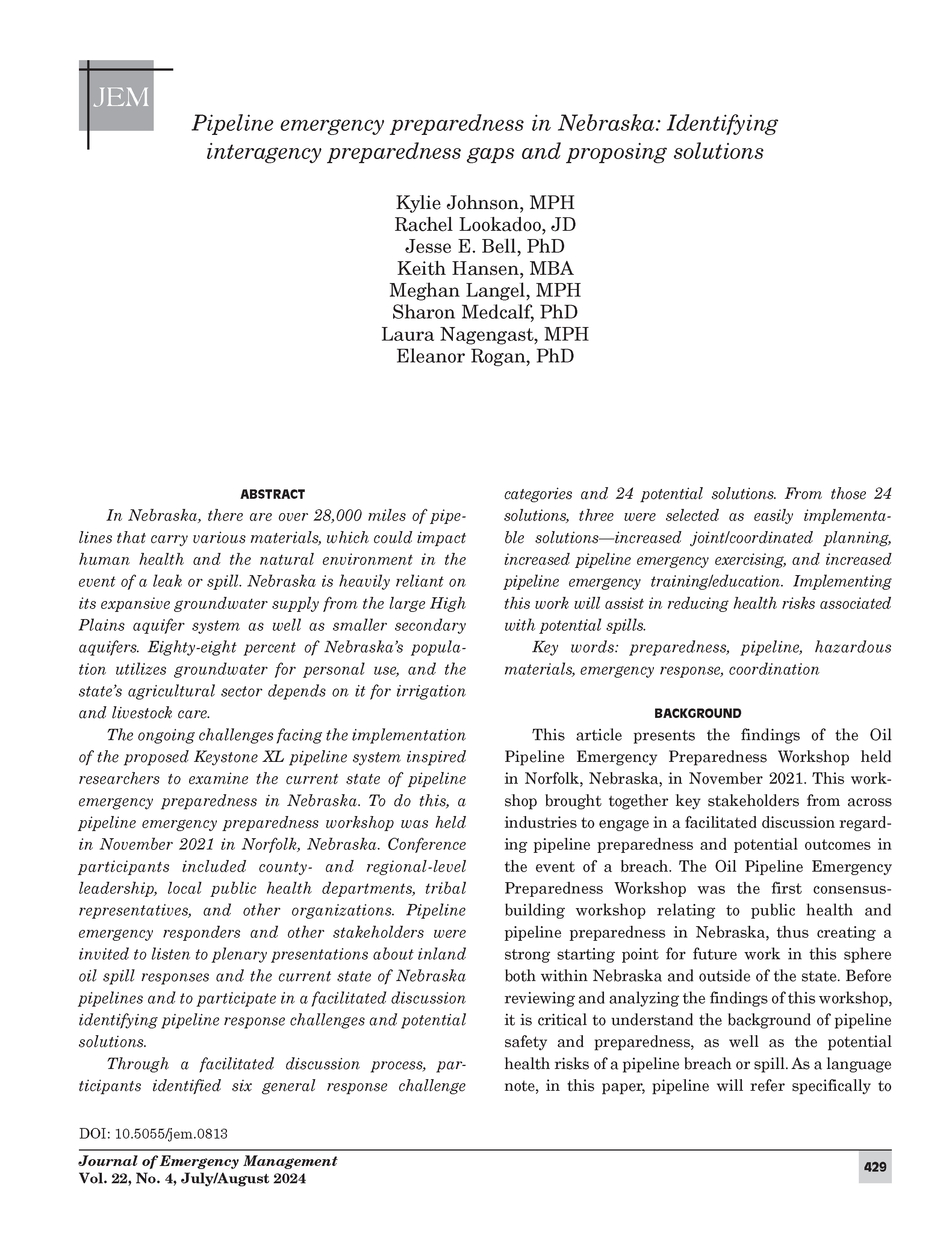Pipeline emergency preparedness in Nebraska: Identifying interagency preparedness gaps and proposing solutions
DOI:
https://doi.org/10.5055/jem.0813Keywords:
preparedness, pipeline, hazardous materials, emergency response, coordinationAbstract
In Nebraska, there are over 28,000 miles of pipelines that carry various materials, which could impact human health and the natural environment in the event of a leak or spill. Nebraska is heavily reliant on its expansive groundwater supply from the large High Plains aquifer system as well as smaller secondary aquifers. Eighty-eight percent of Nebraska’s population utilizes groundwater for personal use, and the state’s agricultural sector depends on it for irrigation and livestock care. The ongoing challenges facing the implementation of the proposed Keystone XL pipeline system inspired researchers to examine the current state of pipeline emergency preparedness in Nebraska. To do this, a pipeline emergency preparedness workshop was held in November 2021 in Norfolk, Nebraska. Conference participants included county- and regional-level leadership, local public health departments, tribal representatives, and other organizations. Pipeline emergency responders and other stakeholders were invited to listen to plenary presentations about inland oil spill responses and the current state of Nebraska pipelines and to participate in a facilitated discussion identifying pipeline response challenges and potential solutions.
Through a facilitated discussion process, participants identified six general response challenge categories and 24 potential solutions. From those 24 solutions, three were selected as easily implementable solutions—increased joint/coordinated planning, increased pipeline emergency exercising, and increased pipeline emergency training/education. Implementing this work will assist in reducing health risks associated with potential spills.
References
Nebraska Department of Environment and Energy: 2020 Nebraska groundwater quality monitoring report. 2020. Available at http://dee.ne.gov/Publica.nsf/PubsForm.xsp?documentId=C3C47F71DBDA83338625863100728C51&action=openDocument. Accessed February 2022.
Divine D, Sibray SS: An overview of secondary aquifers in Nebraska. Lincoln, Ne: Conservation and Survey Division. 2017; 44.
Nebraska’s Natural Resources Districts: Water. 2022. Available at https://www.nrdnet.org/programs/water. Accessed February 2022.
Nebraska Department of Environment and Energy: Nebraska keystone XL pipeline evaluation. Chapter 6. 2013. Available at https://ecmp.nebraska.gov/deq-seis/DisplayDoc.aspx?DocID=rS4EfClRTXYmhsx9VfRjTQ%3D%3D. Accessed February 2022.
Sibray SS, Hallum DR: Petroleum pipelines—Facts and safety. Institute of Agriculture and Natural Resources at the University of Nebraska, Lincoln Extension. 2016.
Pipeline and Hazardous Materials Safety Administration, Transport Canada, Secretaria de Comunicaciones y Transportes: 2020 Emergency response guidebook. 2016. Available at https://www.phmsa.dot.gov/sites/phmsa.dot.gov/files/2021-01/ERG2020-WEB.pdf. Accessed February 2022.
Anderson AR: Health effects of cut gas lines and other petroleum product release incidents—Seven states, 2010–2012. MMWR. Morb Mortal Wkly Rep. 2015; 64(22): 601.
Nebraska Pipeline Association: Nebraska pipeline association. 2021. Available at https://nebraskapipeline.com/home. Accessed February 2022.
Pipeline and Hazardous Materials Safety Administration: Pipeline incident 20 year trends. 2021. US Department of Transportation. Available at https://www.phmsa.dot.gov/data-and-statistics/pipeline/pipeline-incident-20-year-trends. Accessed February 2022.
Nebraska Administrative Code: Title 155 § chapter 1. 1969. Available at https://www.nebraska.gov/rules-and-regs/regsearch/Rules/Fire_Marshal_State/Title-155/Chapter-1.pdf. Accessed February 2022.
United States Code: Title 49 § section 108. Available at https://www.govinfo.gov/app/details/USCODE-2011-title49/USCODE-2011-title49-subtitleI-chap1-sec108/summary. Accessed February 2022.
Code of Federal Regulations: Title 40 § chapter 1. 2021. Available at https://www.ecfr.gov/current/title-40/chapter-I/subchapter-D. Accessed February 2022.
National Volunteer Fire Council, Pipeline and Hazardous Materials Safety Administration: Fire department pipeline emergency response, emergency planning, and preparedness toolkit. 2020. Available at https://www.nvfc.org/wp-content/uploads/2018/07/FD-PREPP-Toolkit.pdf. Accessed February 2022.
Nebraska Department of Environment and Energy: Risk-based corrective action (RBCA) at petroleum release sites: Tier 1/tier 2 assessments & reports revised. 2021. Available at http://www.deq.state.ne.us/Publica.nsf/780613fa1854e3b906256ab60068778a/66fdec793aefc4b286256a93005b8db8?OpenDocument. Accessed February 2022.
Stanfield RB: The Workshop Book. Gabriola, BC: New Society Publishers, 2002.
Code of Federal Regulations: Title 49 § chapter 1. 2021. Available at https://www.ecfr.gov/current/title-49/subtitle-B/chapter-I. Accessed February 2022.

Published
How to Cite
Issue
Section
License
Copyright 2007-2025, Weston Medical Publishing, LLC and Journal of Emergency Management. All Rights Reserved.





